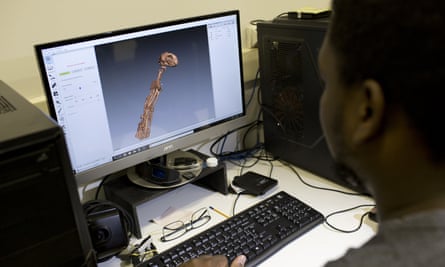While most Brazilians were still reeling from the devastating fire at the country’s National Museum last week, Luana Santos and fellow museum studies students in Rio de Janeiro had started gathering photos and videos of missing items, and even selfies taken by visitors to the vast archive.
Among the 20m items lost in the blaze were Egyptian mummies, the oldest skeleton ever found in Latin America and an irreplaceable collection of indigenous artefacts and research.
But at least something could be salvaged for future generations, Santos and her friends reasoned. Within hours, their appeal went worldwide; so far, it has received 14,000 replies – including videos, photos, written recollections and even drawings of favourite exhibits.
“[The response] shows the importance of the archive – not just a place of research and history, but as part of people’s lives,” said Santos, 28, who studies at the Federal University of the State of Rio de Janeiro.
The group is now in discussions with the same university – which ran the museum – about how to use the material “to show the affection that people had for the museum”, she said.
The impact of the fire – and the scale of the loss –reverberated globally. Unesco technicians have arrived in Rio to help recover what is left of the archive, and museums around the world have offered financial assistance.
But in Brazil, it has prompted a bout of soul-searching: amid reports of museum budget cuts under successive governments and repeated warnings of fire risks at the collection, Brazilians have been asking what the tragedy said about their country – and its attitude to its history.
At least four important public buildings have been hit by fires since 2010. São Paulo’s innovative Museum of the Portuguese Language was destroyed in a 2015 blaze.
“It is part of a process of institutional neglect in a country that does not take care of its history,” said Djamila Ribeiro, a leading academic and commentator.
She said the loss of the museum’s collection of African art and Amerindian artefacts and research reflected Brazil’s ignorance of its African and indigenous heritage, and its indifference to an ignoble history of slavery and oppression.
“The country looks towards Europe. The governing class and middle class think other countries are wonderful,” Ribeiro said.

Long before the fire at the National Museum, historians were dismayed at the neglect of the institution, housed in amansion given to the Portuguese royal family after they fled Napoleon’s army and moved to Rio in 1808.
“It is a strong metaphor for the moment we are going through in Brazil,” said historian Lilia Schwarcz, co-author of the acclaimed Brazil – A Biography, noting that Brazil found billions of dollars to host the 2014 World Cup and 2016 Olympic Games. “How much does the Brazilian government value education and research?”
The Quinta da Boa Vista park, where the museum is located, is a rare open space in Rio’s crowded North Zone suburbs, which helped make it a destination for people from low-income families, said curator Thainã de Medeiros, who helped found a museum highlighting favela evictions.
He asked how Rio found $54m (£41m) to build its futuristic Museum of Tomorrow but couldn’t even pay for a sprinkler system at the National Museum.
Laurentino Gomes, author of the history bestseller 1808, about the arrival of the imperial court, said more people lamented the fire than ever visited the museum.
According to the BBC, 289,000 Brazilians visited the Louvre in 2017, while 192,000 went to the National Museum.
But Gomez argued that the museum’s loss has hit Brazil hard as it lurches through one of the most difficult periods in its recent history, amid soaring violent crime, political disenchantment, recession and calls for a return to military dictatorship.
The fire provoked a discussion about national identity at a difficult moment in the country’s history “as if it was a moment of psychoanalysis”, he said. “The museum is a symbol of all of this – of who we were.
“There is a big discussion on social networks, in all areas, about what it really means to be Brazilian. It is in the crises that we grow.”
